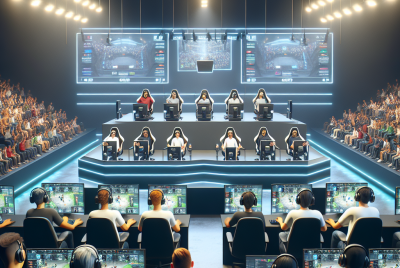Engaging in the Meta: Top FPS Games for Competitors
The Competitive Landscape of FPS Games
Understanding the Meta in FPS Games
In competitive first-person shooters (FPS), “the meta” refers to the current strategies, weapons, and characters that dominate the game at any given time; it’s derived from the term “most effective tactics available.” Players who wish to thrive in the competitive environment must continuously adapt to the changing landscape of these elements. High-level play requires meticulous attention to detail, including map awareness, weapon choice, and team dynamics.
Top FPS Games in the Competitive Arena
1. Counter-Strike: Global Offensive (CS:GO)
Gameplay Mechanics: CS:GO is a team-based shooter that emphasizes tactics, strategy, and skill. Players choose to play as either terrorists or counter-terrorists, completing objectives such as bomb defusal or hostage rescue.
Why It’s Competitive: The game’s depth comes from its intricate gun mechanics, where each weapon behaves differently, and players must master the patterns and recoil. Competitive matches focus on communication and teamwork, making it crucial for players to understand their roles.
Current Meta: As of 2023, the current meta favors the use of rifles like the AK-47 and M4A4, with a focus on utility usage such as smoke grenades and flashbangs for controlling engagements.
2. Call of Duty: Modern Warfare II (2022)
Gameplay Mechanics: The Call of Duty series revolutionized FPS gaming with its fast-paced action and variety of game modes, including team deathmatch, capture the flag, and battle royale.
Why It’s Competitive: With its ever-evolving multiplayer components, players compete in ranked playlists where skill-based matchmaking ensures that players are pitted against opponents of similar skill levels. The systems encourage mastery of movement mechanics and map navigation.
Current Meta: The weapon balancing often shifts, with certain guns being favored for their time-to-kill stats and versatility. Maps undergo revisions, meaning that players need to remain current with the latest strategies.
3. Valorant
Gameplay Mechanics: Valorant is a tactical FPS that merges elements from previous games, notably CS:GO and Overwatch. Players select “agents,” each with unique abilities that affect gameplay.
Why It’s Competitive: The synergy between gunplay and abilities allows for diverse strategies, encouraging teamwork and tactical execution. Map control, communication, and precise execution are essential.
Current Meta: Agent ability usage has become central to the meta, with characters like Jett and Reyna often being preferred for their mobility and duel potential. The importance of economy management mirrors CS:GO’s approach, ensuring that players must balance buying weapons and abilities based on the match situation.
4. Apex Legends
Gameplay Mechanics: Apex Legends features a squad-based system within a battle royale format. Players choose from various characters, each with unique skills, creating a mix of combat and strategy.
Why It’s Competitive: Players must master not only their shooting skills but also understand map rotations, character synergies, and in-game timing. The fast gameplay encourages aggressive engagements and quick decision-making.
Current Meta: The current trends show a preference for characters that synergize well, like Wraith and Valkyrie, who provide mobility for quick escapes and repositioning. The inventory system allows for strategic choices, making item management pivotal.
5. Rainbow Six Siege
Gameplay Mechanics: A tactical FPS that puts emphasis on strategy and teamwork; players take on the role of attackers or defenders in various scenarios. Destruction mechanics and environmental interaction play a huge role.
Why It’s Competitive: The game requires precise shooting, map strategy, and communication. Each operator offers unique abilities that can massively influence rounds, making teamwork crucial to success.
Current Meta: Maps evolve, and the meta often shifts as new operators are introduced. As of 2023, operators like Ash and Jäger are commonly favored due to their utility and presence in the meta.
Essential Elements of Competitive FPS Gaming
1. Communication and Teamwork
In most competitive FPS games, a coordinated team can outperform an individual player with superior skill. Effective communication strategies, such as callouts for enemy positions, coordinating attacks, and sharing resources, can dramatically influence the outcome of matches.
2. Map Knowledge
Understanding map layouts is vital in FPS games. Knowledge of chokepoints, cover spots, and flank routes can provide strategic advantages during engagements. Being aware of enemy movements and predicting where confrontations may occur is a skill that competitive players develop over time.
3. Weapon Mastery
Each FPS game has its arsenal of weapons, including a variety of rifles, submachine guns, shotguns, and sidearms. Mastery of weapon handling, including recoil control, spray patterns, and optimal engagement distances, is important. Players must regularly practice to maintain high proficiency with their preferred weaponry.
4. Adaptation to the Current Meta
As developers patch games and introduce new content, players must be adaptable to shifts in the meta. This includes understanding which characters, weapons, or strategies are currently favored and adjusting gameplay accordingly. Staying informed through community sources and professional tournaments is essential for top-level play.
Maintaining a Competitive Edge
1. Regular Practice
Consistent practice keeps skills sharp. Many competitive players set aside dedicated time to refine their aiming skills, strategy execution, and game sense. Tools like aim trainers or custom game modes can be invaluable.
2. Analyzing Gameplay
Reviewing past matches can help identify weaknesses in gameplay. Many players record their sessions to critique their decision-making, aiming, and communication with teammates. This self-analysis contributes significantly to improvement.
3. Following the Community and Professional Scene
Pro players and streamers provide insights into gameplay and strategies that can help aspiring competitors. Engaging with a community through forums, social media, and tournaments boosts knowledge of current trends and tips.
Conclusion
Excelling in competitive FPS titles requires commitment and adaptability. Understanding the meta, honing skills, communicating effectively, and learning from both successes and failures are paramount in striving for greatness in the competitive gaming landscape. Engaging in multiple FPS games can enhance a player’s overall experience and versatility, providing a well-rounded skill set.




